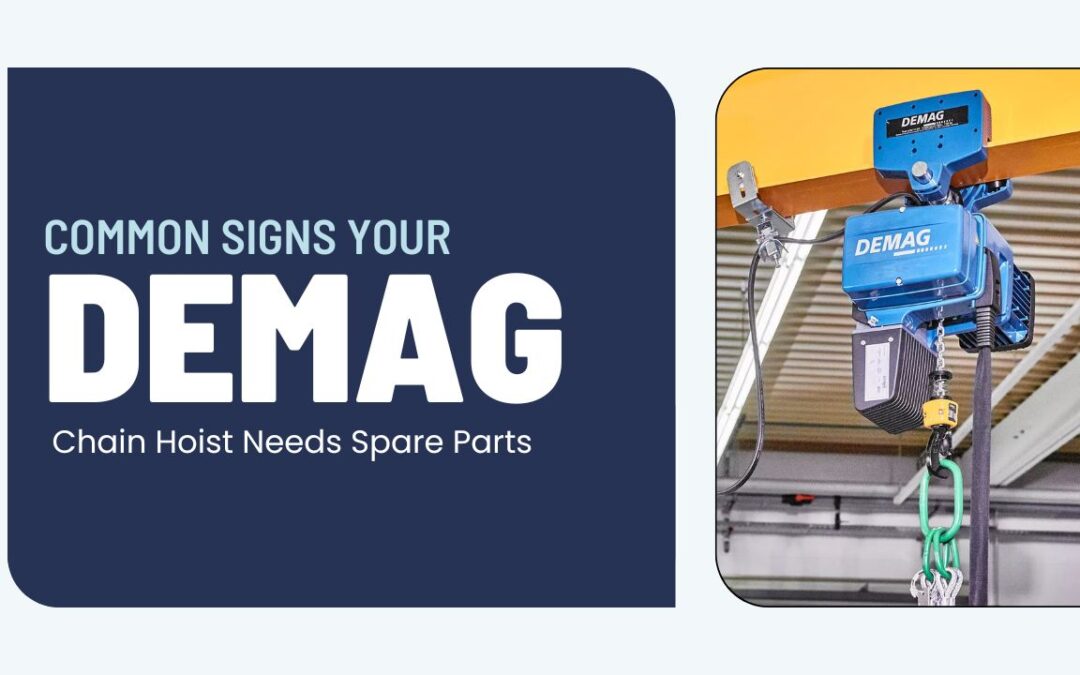Chain hoists are critical components in various industries, from manufacturing to construction, enabling the lifting and moving heavy loads with precision and ease. Among the top choices, Demag chain hoists are known for their durability and high-performance standards. However, like any mechanical equipment, they require routine maintenance and occasional spare parts replacements to continue functioning effectively. Identifying when your Demag chain hoist needs servicing or part replacement can prevent costly breakdowns and ensure safe operations. Here, Gayatri Technologies provides a detailed guide on recognising common signs that indicate your Demag hoist may need attention.
1. Importance of Regular Maintenance for Your Demag Chain Hoist
Routine maintenance is the first line of defence for ensuring the longevity and efficiency of your Demag hoist. A well-maintained hoist can last for years, even in demanding environments. Through Demag chain hoist service and maintenance, you can identify minor issues before they escalate, extend the equipment’s lifespan, and improve safety on the job site. Consistent maintenance also allows you to plan for part replacements, reducing the risk of unexpected breakdowns.
To effectively care for your Demag chain hoist, familiarise yourself with its operating manual and follow a structured maintenance routine. This guide will help you spot early warning signs that signal a need for part replacement or servicing.
2. Signs of Worn or Damaged Chains
Chains are the lifeline of any chain hoist, bearing the load’s weight and ensuring it is safely moved from one point to another. Over time, the chains may show signs of wear and tear, which, if ignored, can lead to severe accidents. Here are signs that your chain may need replacement:
- Visible Wear and Elongation: Regular use causes the chain links to elongate, weakening their capacity to bear loads. Check for signs of chain elongation or thinning, which indicate weakening links.
- Rust or Corrosion: Exposure to moisture and environmental elements can cause rust or corrosion, making the chain brittle and less reliable.
- Deformation or Bending: Any chain links that are visibly bent or distorted must be replaced immediately. Bent links compromise the hoist’s load-bearing capacity.
Scheduling regular inspections as part of your Demag chain hoist maintenance guide will help you monitor the chain’s condition and replace it when necessary, avoiding potential breakdowns.
3. Unusual Noises During Operation
A smoothly functioning Demag chain hoist should operate quietly, with minimal friction noise. However, unusual sounds such as grinding, squeaking, or rattling indicate potential issues requiring spare parts. Here’s what these sounds may mean:
- Grinding or Squealing: These sounds often indicate a lack of lubrication or issues with internal components, such as bearings or gears. Adding lubrication or replacing worn parts can resolve the issue.
- Clicking or Rattling: This sound is typically associated with loose or misaligned parts. These loose parts can cause wear and tear on other components, leading to a more significant failure.
Unusual noises should be treated as warning signs in the Demag hoist parts troubleshooting. Ignoring them can damage the hoist severely, leading to costly repairs or even total replacement.
4. Sluggish or Jerky Movements
Smooth and controlled movements are a sign of a properly functioning hoist. If your Demag chain hoist begins to operate in a sluggish or jerky manner, it could be due to several issues that warrant inspection:
- Chain Misalignment or Binding: When the chain is not aligned correctly, it may catch or bind during operation, causing jerky movements. This can be fixed by readjusting the chain alignment.
- Worn-Out Gears: Gears are crucial in controlling the hoist’s movements. If the gears are worn, they may cause the hoist to hesitate or jerk while lifting. Replacing worn gears is essential to maintaining smooth operation.
- Electrical Issues: Issues with the control circuits or motor can lead to sluggish performance in electrically operated hoists. Electrical troubleshooting may be necessary to diagnose and resolve the issue.
5. Overheating or Burning Smells
Overheating is a severe concern for hoist operators, as it can signify mechanical or electrical issues. If your Demag chain hoist emits a burning smell or feels unusually warm to the touch, it may be due to:
- Overworked Motor: Motors can overheat when the hoist is overloaded or used continuously without breaks. Reduce the load or allow cooling time between uses to prevent motor burnout.
- Faulty Wiring or Electrical Components: Burning smells can also result from faulty wiring or overheating in the control panel. Immediate attention is necessary to avoid electrical fires or component failure.
- Poor Ventilation: Ensure the hoist’s motor and electrical components have adequate ventilation to dissipate heat during operation.
6. Decline in Load Capacity
A key sign that your host needs spare parts or servicing is a noticeable decline in load capacity. If your hoist struggles to lift loads that it previously handled with ease, there may be underlying mechanical issues that require attention. Possible reasons for a decrease in load capacity include:
- Stretched or Weakened Chains: Chains that have elongated or weakened over time will reduce the hoist’s ability to handle heavy loads safely.
- Worn or Damaged Load Hook: The load hook should be checked for signs of wear or deformation. A worn hook can compromise the hoist lifting capability and should be replaced immediately.
- Gear and Motor Issues: Worn gears or a failing motor can cause the hoist to struggle with lifting. Addressing these issues promptly can restore the hoist’s load-handling performance.
Performing routine load testing as part of Demag chain hoist service and maintenance can help detect capacity declines early, allowing for necessary repairs or part replacements.
7. Inconsistent Braking Performance
A properly functioning hoist brake is crucial for safe operation, as it ensures the load is held securely in place when the hoist is not in motion. Signs of braking issues include:
- Delayed Response: If the brake does not engage immediately when lifting or lowering stops, it indicates wear in the brake pads or faulty brake components.
- Slipping or Dropping Loads: A failing brake may allow the load to slip or drop unexpectedly, posing a significant safety risk.
- Noisy Braking Mechanism: Unusual sounds during braking suggest worn or damaged parts within the braking mechanism.
Inconsistent braking performance is one of the critical signs of a broken Demag chain hoist and requires immediate attention.
8. Electrical Malfunctions or Control Issues
If your hoist’s control panel begins to malfunction, it strongly indicates that the electrical components need servicing. Symptoms of electrical issues may include:
- Unresponsive Controls: If the controls do not respond reliably, it could be due to wiring issues, a faulty control switch, or a worn-out control unit.
- Erratic Operation: Sudden starts, stops, or speed changes often indicate an electrical fault within the hoist’s circuitry.
- Indicator Light Errors: Modern hoists often have indicator lights that show their operational status. Inspecting the electrical components is essential if these lights display errors or fail to light up.
Conclusion
Recognizing the early warning signs of wear or malfunction in your Demag chain hoist ensures safe and reliable operation. From unusual noises to inconsistent braking, each symptom points to specific issues that may require part replacement or servicing. By staying vigilant and performing regular Demag chain hoist service and maintenance, you can prevent costly repairs and extend the lifespan of your equipment.

